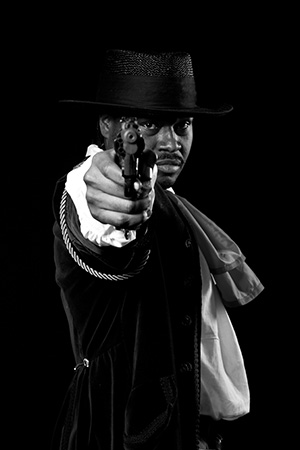Zaina Salem
A mix of University of Akron alumni and current students performed a historic play in celebration of Black History Month, hosted by the Summit Artspace.

“The Emperor Jones,” originally performed in the 1920s, is a culturally significant play by American dramatist Eugene O’Neill. It tells the story of Brutus Jones, an African American railway worker who became a killer and escaped as a convict to the Caribbean Islands. There, he adopts the role of emperor, self-proclaiming his rule over the island. Jones has obtained a corrupt value system from upper-class white Americans, and the people on the island rebel against him. The play is a series of flashbacks from the perspective of Jones as he makes his way through the forest to escape from former subjects who have turned against him.
Beneath the forest lie distractions from the Emperor’s escape. The food he had hidden among the trees before fleeing seems to have vanished. His leather shoes are left behind in the forest for lighter travel, but then needed for relief of sore and rough feet later. He becomes hungry and exhausted. Nothing seems to be going as planned for the Emperor.
The forest, dark and lonely, is also the place that fosters ghosts disguised as the Emperor’s personal fears and sins. These strikingly realistic ghosts, people and things from his past, mock the Emperor for his wrongdoings.
The chilling scene of Jones in a slave auction – a memory fashioned by the ghosts – is what sends him over the edge. The Emperor starts to beg God for mercy and forgiveness. 
Once a fearless and confident man, the Emperor gradually becomes overwhelmed with sensations of hopelessness and frustration. As the drumbeats of his enemies become increasingly louder, he loses motivation and courage.
“The Emperor Jones” is a cross between expressionism and realism. The play presents a lesson that teaches the dangers of denial and gives a good look at what could happen if you reject who you are.
There are eight scenes in the play, and six of those are from the point of Jones. No other characters speak during these six scenes.
The Emperor is portrayed by Traviel Cody, who played his character with perfect charisma. Each actor’s performance was impeccable and truly made the play worth viewing. It was evident that the audience felt the emotion and excitement the actors exuded.
“It was a powerful play, even if the setting was mediocre. The acting definitely made up for the limited scenery and props,” said attendee Nasser Salem.
The director of the play, Lois Elswick, has been involved in theater since the age of seven. Elswick received her bachelor’s in theater from Case Western Reserve University in 2006.
“I was cast as the lead in an elementary school play and have never stopped loving theater since,” she said.
Eugene O’Neill is Elswick’s favorite playwright, and this is the third O’Neill play that she has directed. Elswick also writes her own plays, and the company she currently directs for, Cody Enterprises, is planning to produce her new play called “Please Hang Up and Try Again,” this summer.
“The benefits of being a play director are many,” Elswick said. “You get to see your vision of a play produced before your own eyes and with each production, you get to work with different actors and also help them hone their craft of acting.”
Overall, the play was very enjoyable to watch. It was obvious the actors spent a great amount of time practicing and preparing to give the audience a wonderful experience. The performance was truly unforgettable.





